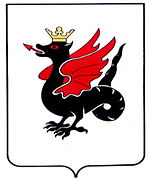Zilant
A Zilant is a legendary creature with the head of a dragon, the body of a bird, the legs of a chicken, the tail of a snake, the ears of a canine, the red wings of a bat or bird, sharp teeth, dark-gray feathers and scaly dark-gray skin.
The word Zilant is the English transcription of Russian Зилант, itself a rendering of Tatar yılan/елан, pronounced [jɯˈlɑn] (or sometimes [ʒʲɯˈlɑn]) and meaning a snake.
The Tatars themselves, on the other hand, frequently refer to this creature with the Persian word Ajdaha (dragon)[2] or Ajdaha-yılan ('Dragon-snake').
Aq Yılan[4] or Şahmara[5] (from Persian shah (king) and ymar (snake)[6][7] advised and helped epic heroes (batırlar),[8] often by giving them gifts.
Snakes with wings appear in legends in Tartar culture, and a dragon – ajdaha – plays a role in fairy tales.
According to other stories, the giant snake was transformed into Diü, a spirit who founded the underwater kingdom of the lake.
It is also said that Zilant did not escape to the lake but instead tried get revenge upon the knight, who by that time had ridden some 50 çaqrım[9] away from Kazan.
The knight, however, had managed to stab the dragon with his poisoned pike, and Zilant eventually died.
Although the Bulgars adopted Islam as early as the 10th century, the snake survived until the time of Tamerlane's invasion after which it disappeared.
Ibn Fadlan, who visited Volga Bulgaria in the 10th century, referred to numerous snakes, especially in trees.
The popular historian Lev Gumilyov pointed out in his Ancient Turks that the Kypchaks, one of the ancestors of modern Tatars, came from the Zheliang[12] Valley in the Altay Mountains.
If there is any truth in Lev Gumilyov's idea, then the dragon of Kazan should be regarded as a remnant of the once popular Turkic totem.
Many scholars believe that Zilant, like other flying snakes, symbolized the evil rulers of the neighboring pagan peoples.
Sceptics say that the Bulgars purposefully spread those legends in the border regions in order to dismay their neighbors.
Zilantaw Hill (originally Tatar Yılantaw, Елантау, Жылантау,[14] Snake Mount),[15] associated with Zilant legends, was formerly situated on the bank of Kazanka River.
It is probable that a small settlement, not the city of Kazan, had existed at Zilantaw in the Bulgarian epoch (12th–14th centuries).
The most ancient layer contained indications of a great fire, lending support to the legend about the burning of the snakes.
Early Russian images represent Zilant with one head, four chicken legs, a bird's body and a snake tail.
They also pointed out that Zilant might be construed as the dragon killed by Saint George as represented on the Coat of arms of Moscow.
It was eventually decided that Zilant should be associated with Aq Yılan (White Snake) as a positive Turkic spirit.






